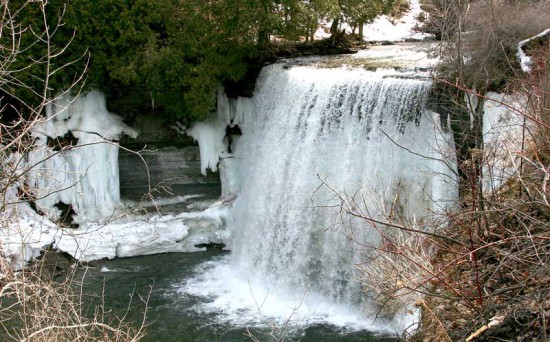MANITOULIN—Local representatives are not the least bit surprised with a study released last week that shows it is plausible Asian carp have reached the Great Lakes. The scientific report released last week provided laboratory analysis that turned up positive hits for bighead or silver carp DNA in western Lake Erie.
“I would think they are in the Great Lakes. No, it doesn’t startle or shock me,” said Jim Sloss, chair of the United Fish and Game Clubs of Manitoulin (UFGCM), to the report.
“I’m sure they are in the Great Lakes and have been for at least a year or so,” stated Mike Wilton, of Spring Bay, on Monday. “I would put money on it. I know a report I read recently said there was a group that found carp DNA in Lake Michigan a couple of years ago.”
“Meanwhile there are committees set up that will sit and ponder how to stop them reaching our lakes, or what to do when they are confirmed, which is already the case,” said Mr. Wilton.
The scientific report released last week indicated that at least some Asian carp have gotten into the Great Lakes, but that there is still time to stop them from getting established and unravelling food chains that support a $7 billion fishing industry and sensitive ecosystems.
The Associated Press (AP) explained the report was written by experts who pioneered the use of genetic data to search for the fish, and the paper disagrees with government scientists who feel many of the positive Asian carp DNA hits recorded in or near the lakes in recent years could have come from other sources, such as excrement from birds that fed on carp in distant rivers.
Christopher Jerde of the University of Notre Dame (the lead author of the report) told the AP that the most plausible explanation is still that there are some carp out there. However, he said he is cautiously optimistic that they are not at the point where they will be reproducing, spreading further and doing serious damage.
The paper summarized findings by Mr. Jerde and other scientists from Notre Dame, the Nature Conservancy and Central Michigan University during two years of searching the Great Lakes basin for Asian carp. The fish have migrated northward in the Mississippi River and many tributaries since escaping from Deep South ponds in the 1970s. Scientists fear they will out-compete prized sport and commercial species, the AP reported.
In the study carried out between September 2009 and October 2011, Mr. Jerde and his colleagues collected more than 2,800 water samples from parts of the Great Lakes and tributary rivers. The samples were poured through microfiber filters to extract DNA, which fish shed in their excrement, scales and body slime.
The laboratory analysis turned up 58 positive hits for bighead or silver carp in the Chicago area waterway system, a network of rivers and canals linked directly to Lake Michigan, and six in western Lake Erie. Some of the Chicago DNA was found in Lake Calumet, where a live bighead carp was caught in 2010.
Mr. Jerde told the AP he feels there is at least some evidence for Asian carp being present in southern Lake Michigan, however the question is how many.
CBC News reported that a recent sampling by the US Army Corps of Engineers and other federal agencies also yielded positive results in the Chicago waterways. But while the government team acknowledges the presence of Asian carp genetic fingerprints, it disagrees that they necessarily signal the presence of live fish.
The issue is significant because it could influence the debate over whether to seal off Lake Michigan from the Chicago waterways, a mammoth engineering task that would cost billions of dollars and take years to complete. The AP reports five states sought that step in a lawsuit dismissed by a federal judge last December. Under pressure from Congress, the United States Army Corps of Engineers has pledged to offer options for preventing species migrations between the Great Lakes and the Mississippi River watershed later this year.
The USACE reports that an electric barrier in a canal 37 miles from Chicago is preventing the carp from getting through, even though their DNA has turned up repeatedly on the other side. In a February report, federal agencies said the genetic material could have been transported by bird feces, fish sampling gear, barges and storm sewers.
However, the AP report that the Jerde team’s paper, published last week by the Canadian Journal of Fisheries and Aquatic Species, argues that the likeliest explanation remains the presence of live Asian carp.
Mary Muter, chair of the Great Lakes section of Sierra Club Ontario, told the Recorder, “this is the same as the report earlier about carp DNA found at the south end of Lake Michigan. It does not mean they are sure carp are present, some scientists say that it does while others say this isn’t the case. For instance, in Lake Erie because it is so murky you can’t see them (carp) in shallow water, so it is anyone’s guess whether they have reached Lake Erie.”
“But there are rivers that drain into Lake Erie, during flooding there is a connection to two rivers in the Chicago River and tributaries that can flood, and they (carp) could be up the Chicago River,” said Ms. Muter.
“Certainly this is not good news. And there is a potential risk assessment for Lake Huron and Georgian Bay,” said Ms. Muter. “And given the number of eggs for instance silver carp produce-they reproduce four times a year, once they get into an area waterway they will not be stopped.”
“I think the issue of carp is going to be just like the sea lamprey, they are here and it is just a fact of life,” added Mr. Wilton.





